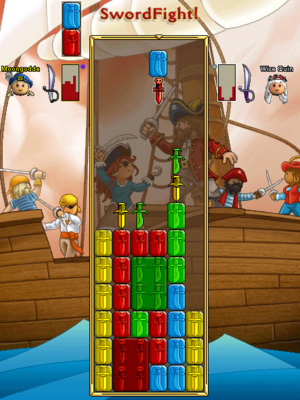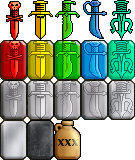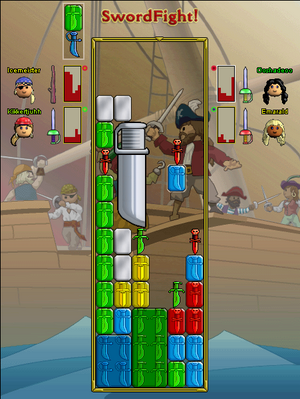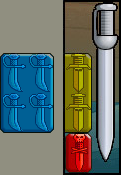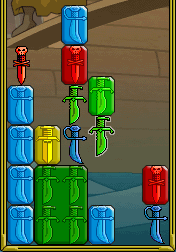Swordfight
Swordfighting (often abbreviated as SF or sf) is a multi-player parlor game. It is sometimes referred to as a brawl when it is played with more than two people, or a fray when played against NPP monsters.
Swordfighting is free to play three days a week. Swordfighting at sea, challenges, and monster frays are always free.
Contents
Where to play
Swordfighting is a commonly encountered activity in the pirate world, and can be played in many different settings:
- Swordfighting can be played at any Swordfighting table. Additionally, players can take part in swordfighting tournaments.
- Players can challenge NPPs or other players to play the puzzle in two-player mode.
- The final phase of a sea battle may involve either a swordfight or a rumble.
- While exploring Atlantis or the Haunted Seas, players may be challenged to a duel by boarders. Additionally, all players aboard a ship that has entered a citadel or a graveyard will be launched into a shipwide swordfight. Finally, Cursed Isles explorers who have landed at the island must face ever-growing numbers of cultists in swordfighting bouts.
- Skeleton NPPs may sometimes occupy an island, refusing to leave until they are defeated in a swordfighting fray.
Controls
Though controls can be customized under the options screen, the default controls are as follows:
- Left and Right arrows - move left and right
- Up and Down arrows - rotate counter-clockwise and clockwise
- Space - drops quickly
- A and S - switches opponent up/down
- [ and ] - same as A and S
Gameplay
Swordfighting is about clearing pieces from the board in order to fill up the opponent's board. As the fight progresses, boards become more difficult to keep clear as there are more pieces in play and incoming attacks get larger.
The board
The swordfighting board is 6 tiles wide by 13 high, giving a total of 78 spaces.
There are two sets of pieces that enter the swordfighter's board. One is a series of random pieces which the swordfighter can move and place where he or she wants to; these fall from the top of the fourth column in pairs at a steady pace. The other contains the opponent's attacks; these attacks enter the board independently of the player. Most of the opponent's attacks will fall from the top, but some (horizontal strikes) may enter the board from the side.
On each side of the board, the teams are visible together with their swords. The opponent is always shown on the right. A miniture rectangle beside each opponent's name gives a rough indication of how blocks are distributed on the opponent's screen. This preview updates every few seconds. Teaming configurations are shown as dots beside each pirate's preview; these configurations are updated in real-time.
Piece types
There are two different classes of pieces in swordfighting: solid blocks and cutout blocks ("breakers"). Solid blocks will land and remain on the board, whereas breakers will shatter all connected pieces of the same color and send an attack proportional to the size of the shatter to the opponent. These attacks are described in detail in the Creating attacks section. Note that two blocks are considered adjacent if they are side-by-side or one is above the other (diagonal adjacency does not count), and two blocks are connected if a path of adjacent blocks exists between them.
Blocks and breakers come in one of four standard colors: red, yellow, green, and blue. Each color piece depicts a different sword; for instance the red block and breaker always has the appearance of a skull dagger. In some other settings additional pieces are introduced:
- In sea battles, solid black blocks represent damage pirates have taken. These blocks occupy spaces on the board from bottom to top. A maximum of 6 rows (36 blocks) can be added to a swordfight board by ship damage. Jug-shaped blocks indicate that the ship is out of rum; these occupy the leftmost and rightmost columns of the swordfighting board. As neither of these block types can be removed from the board, they have the effect of making the swordfight more difficult to win.
- Swordfights in Atlantis add a fifth aqua block and breaker in the shape of a trident for when a pirate is facing dragoons. These pieces behave the same as the standard colors.
- Swordfights in Haunted Seas frays against ghostly enemies add a purple block. Unlike the standard blocks, they will not fuse together. They can be cleared with breakers of any color, as long as they are touching the pieces which break. Any adjacent breaker can clear purple blocks, however if breaker is adjacent to only purple blocks, it does not act as an universal block and only the purple is cleared. Markings on each block show how many pieces can enter the board before it turns in to an unclearable black block. The developers have stated they have no intention of adding purple blocks to other environments such as pillaging, tournaments, or player duels. [1]
Creating attacks
Swordfighting clears, also known as "attacks", come in two flavors depending on how the blocks were arranged before they were shattered. These types are minor breaks ("sprinkles"), which enter the board as individual opaque gray blocks, and major breaks ("strikes"), which enter the board as sword images. It is possible to send multiple attacks of either type at the same time, known as a combo. Note that when attacks are received, they only include blocks, never breakers.
The piece that each opaque block finally turns into is determined by the drop pattern of the opponent's sword. Some swords produce drop patterns that are harder to clear than others, thus making the choice of sword an important one. The sword's drop pattern is the only effect a sword has on the puzzle.
The complete swordfighting mechanics behind the placing of attacks on an opponent's board are extensive and complicated. Suggestions for further reading can be found in the External/other links section below.
Note that NPPs do not receive attacks in the same way that a player would. Attacks sent to them will not necessarily have the same effect as they would versus players, although proportionally more damage is still dealt by larger attacks.
Strikes
Like-colored blocks solidify into a large block of the same color if they are arranged in a 2 x 2 or greater rectangular formation. When this fused block shatters, it sends a sword "strike" to the opponent. A strike lands on the opponent's board as an immovable image of a sword for one turn, and then becomes an opaque gray block. These gray blocks only remain on the board temporarily, as they decay to translucent blocks the following turn, and become standard blocks after that.
Fused blocks that are square or taller than they are wide send vertical swords of the same dimensions to the opponent, while those that are wider than they are tall send horizontal swords of the same dimensions. The known exceptions to this rule are:
- A 2x2 fused block becomes a 1x4 sword.
- A 3x3 fused block becomes a 2x4 sword.
- If a fused block would become a vertical sword, and it is wider than 3 blocks, then any excess width is subtracted and added to its height. E.g. a 5x5 block would become a 3x7 sword. Likewise, if a fused block would become a horizontal sword and it is higher than 3 blocks, then any excess height is subtracted and added to its width. E.g. a 5*4 block would become a 6*3 sword.
- One turn before it enters the opponent's board, a horizontal sword will become a vertical sword if at least half of it cannot enter the screen.
Sprinkles
All unfused blocks are sent as "sprinkles", or individual opaque gray blocks. As with strikes, these gray blocks gradually decay into standard blocks.
One sprinkle block is sent to the opponent for every two loose blocks (including breakers) that are shattered. If an uneven number are broken, the value is rounded down. If multiple sets of blocks are broken at once (e.g. a group of 5 pieces, and another group of 4 pieces) then each attack is calculated separately, and the resultant attacks are added up. In the example, the final number of sprinkles would be 2 + 2 = 4.
Chaining
Attacks can be greatly magnified by including them in part of a chain. When a block is broken, the pieces above it fall onto the pieces below. If, after the pieces have fallen, a breaker becomes adjacent to a series of blocks, then those blocks are also broken. The "chain" continues until no more blocks can be shattered in this way. Being able to make double, triple, bingo, donkey, vegas, or greater chains, will multiply the attacks sent. The nth link in the chain acts as an n-times multiplier. For example, attacks sent during a double are magnified by 2. Similarly, attacks sent during a donkey are magnified by 5.
Chains are applied to strikes and sprinkles as follows:
- With strikes, chains are applied to fused blocks before they are converted into swords. A chain will multiply the largest dimension of the block. If the dimensions are equal, the height is multiplied.
- With sprinkles, the final number of sprinkles to be sent are multiplied accordingly. For instance, if 5 pieces were shattered as part of a "single" (1x multiplier) and 4 were shattered as part of a "double" (2x multiplier), then the result would be 2(1) + 2(2) = 2+4 = 6.
Winning
A player loses when their fourth column becomes completely full (meaning no more pieces can enter the board). In a two-player swordfight, the opponent wins when this happens. In a team swordfight, the team wins once all opponents have been eliminated in this way.
As with most multiplayer puzzles, it is possible for a player (or team) to win the game due to the opponent (or team) forfeiting or disconnecting.
Instakills
- Main article: Instakill
An instakill, or insta, happens when a sword lands in the board's fourth column, eliminating that player instantly. It is not possible to instakill a player with sprinkles, as sprinkles refuse to land in the top of the fourth column. These types of attacks are often employed in multiplayer swordfights, where due to teaming conventions it is likely that some players will be able to design their chains unhindered by incoming attacks.
Influences
This puzzle's mechanics were heavily influenced by Super Puzzle Fighter 2 Turbo for arcades and later various consoles, which later influenced Puzzle Kombat (part of Mortal Kombat Deception for the PlayStation 2).
Historical notes
- In the original version of the sea battle swordfight, a maximum of 10 rows of black blocks could be achieved (if a ship had become fully damaged). This was lowered to 6 rows in Beta release 2003-11-22. The amount of black blocks a cannonball added was not changed, just that the maximum damage level for swordfighting was lowered.
- Rum bottles in the sea battle swordfight in release 2005-04-26. Previously if a ship was out of rum, there was no penalty in swordfights.
Ultimate list
| Cerulean | Emerald | Ice |
|---|---|---|
| Jade | Meridian | Obsidian |
| Opal | ||
Trophies
The following trophies are related to swordfighting:
- Swordfighting Trophies
External/other links
- Commonly discussed ideas from Game Design
- Official game documents
- Stalling
- Black Death Sword and Sprinkle Placement Guide
- Tedv's Everything about Everything about Swords post (somewhat outdated)
- RobertDonald's Swordfighting Guide Relevant
- Jack's Strike Pattern Inner Workings explains what the opponent gets
- Alexaleo's Breaker Stacking Swordfighting Video
- Swordfighting Video
- Scervy's Youtube Defeating Advanced Players Swordfight Guide
- Bailet's Swordfighting video - Saber and Falchion
- Guantanamo's swordfighting montage
| |||
| See also: Swordfighting | Drop pattern | Brawl | |||
| |
| See also: Tournament |
